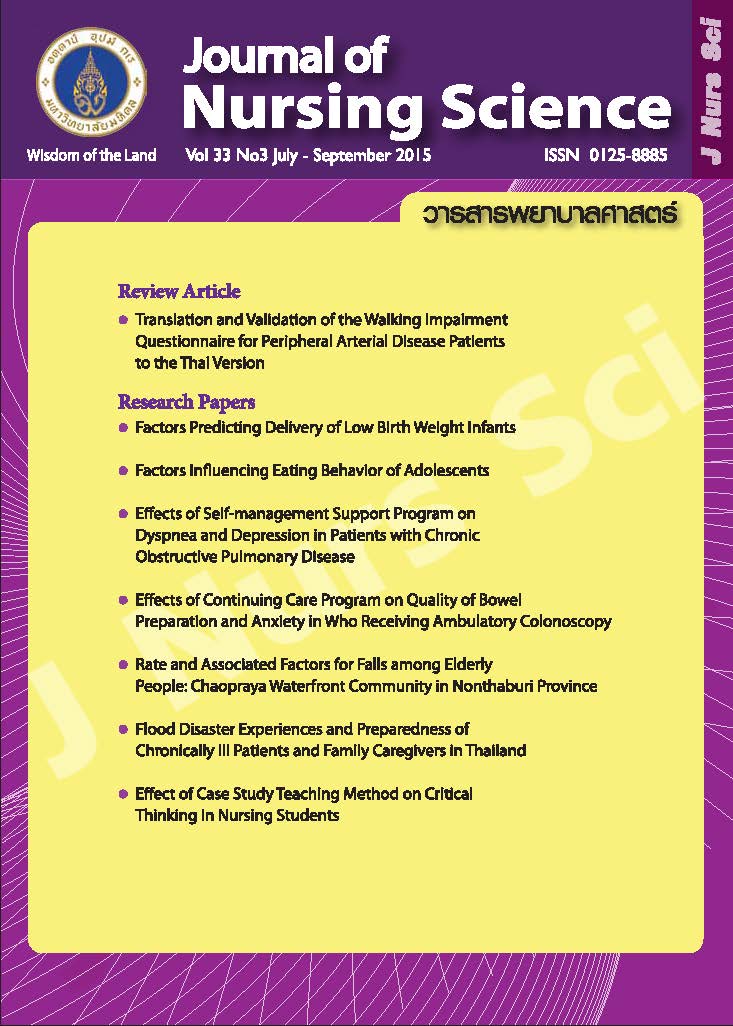Factors Influencing Eating Behavior of Adolescents
Main Article Content
Abstract
Purpose: To examine predictive factors of knowledge of metabolic syndrome, perceived benefits, perceived barriers, and perceived self-efficacy on eating behavior of adolescents.
Design: Correlational predictive design.
Methods: The participants were 227 adolescents studying in Grade 10 in a public school, Bangkok, Thailand. Questionnaires were used for data collection. Data were analyzed by using descriptive statistics, Pearson’s product moment correlation coefficient, and multiple regression analysis.
Main findings: Only two factors that could predict eating behavior of adolescents were perceived self-efficacy (b = .10, p < .01), and perceived barriers (b = - .07, p < .05). Eating behavior was predicted greatly by perceived self-efficacy (β = .18, p < .01), and followed by perceived barriers (β = - .15, p < .05). All related factors could jointly explain 7% of the variance in eating behavior (R2 = .07, p < .01).
Conclusion and recommendations: Perceived self-efficacy and perceived barriers are two predictive factors of eating behavior in adolescents. Therefore, health care providers, teachers, school administrators, food sellers, and parents should jointly seek out possible strategies to decrease barriers of healthy eating for these adolescents both at school and at home. Activities for promoting self-efficacy of these adolescents should be encouraged in order to enhance their healthy eating behavior.
ปัจจัยที่มีผลต่อพฤติกรรมการบริโภคอาหารของวัยรุ่น
บทคัดย่อ
วัตถุประสงค์: เพื่อศึกษาอำนาจการทำนายของปัจจัยด้านความรู้เกี่ยวกับภาวะเมตาบอลิคซินโดรม การรับรู้ประโยชน์ การรับรู้อุปสรรค และการรับรู้สมรรถนะตนเองในการบริโภคอาหารต่อพฤติกรรมการบริโภคอาหารของวัยรุ่น
รูปแบบการวิจัย: การวิจัยเชิงทำนายความสัมพันธ์
วิธีดำเนินการวิจัย: กลุ่มตัวอย่าง คือ วัยรุ่นซึ่งเป็นนักเรียนชั้นมัธยมศึกษาปีที่ 4 ในโรงเรียนรัฐบาลกรุงเทพมหานคร จำนวน 227 ราย เก็บรวบรวมข้อมูลโดยใช้แบบสอบถาม วิเคราะห์ข้อมูลโดยใช้สถิติพรรณนา ค่าสัมประสิทธิ์สหสัมพันธ์ของเพียร์สัน และการวิเคราะห์ความถดถอยแบบพหุคุณ
ผลการวิจัย: การศึกษาครั้งนี้พบเพียง 2 ปัจจัยที่สามารถทำนายพฤติกรรมการบริโภคอาหารของวัยรุ่น ได้แก่ การรับรู้สมรรถนะตนเอง (b = .10, p < .01) และการรับรู้อุปสรรค (b = - .07, p < .05) โดยพบว่า การรับรู้สมรรถนะตนเองมีอิทธิพลสูงสุด (β = .18) และการรับรู้อุปสรรคมีอิทธิพลที่รองลงมา (β = - .15) และพบว่าปัจจัยทั้งหมดสามารถร่วมกันทำนายความแปรปรวนของพฤติกรรมการบริโภคอาหารของวัยรุ่นได้ร้อยละ 7 (R2 = .07, p < .01)
สรุปและข้อเสนอแนะ: ปัจจัยที่สามารถทำนายพฤติกรรมการบริโภคอาหารของวัยรุ่น คือ การรับรู้สมรรถนะตนเอง และการรับรู้อุปสรรค ดังนั้น บุคลากรสุขภาพ ครู ผู้บริหารโรงเรียน และผู้ประกอบการ้านค้า ในโรงเรียน รวมทั้ง ผู้ปกครองควรมีส่วนร่วมในการวางแผน หาแนวทางในการลดอุปสรรคต่างๆ ในการบริโภคอาหารสุขภาพของวัยรุ่นเหล่านี้ ทั้งที่โรงเรียนและที่บ้าน และหาแนวทางการจัดกิจกรรมเพื่อส่งเสริมการรับรู้สมรรถนะตนเองของวัยรุ่นจะทำให้วัยรุ่นปรับเปลี่ยนพฤติกรรมการบริโภคอาหารของตนเองให้เหมาะสมมากขึ้น
คำสำคัญ: พฤติกรรมการบริโภคอาหาร ภาวะเมตาบอลิคซินโดรม วัยรุ่น
Article Details
Copyright Notice: Nursing Science Journal of Thailand has exclusive rights to publish and distribute the manuscript and all contents therein. Without the journal’s permission, the dissemination of the manuscript in another journal or online, and the reproduction of the manuscript for non-educational purpose are prohibited.

Disclaimer: The opinion expressed and figures provided in this journal, NSJT, are the sole responsibility of the authors. The editorial board bears no responsibility in this regard.


